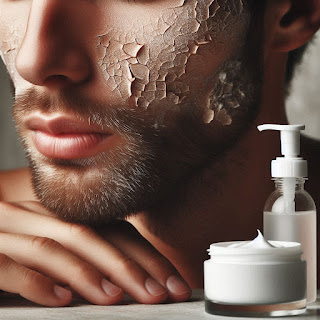Skincare Routines for different Skin Types
Customizing skincare routines for different skin types
involves a combination of understanding individual needs, selecting appropriate
products, and maintaining consistency in skincare habits. It's essential to
listen to your skin, observe how it responds to different products, and adjust
your routine as needed to achieve healthy, balanced skin.
If you still don't know the type of skin you have, I'm
sharing here some tips that you can use to help you find out. So, these are the
recommended skincare routines for each skin type, however, it is always good to
consult with your dermatologist so that you are sure that you will use the most
suitable for your skin.
Normal Skin
Characteristics: Normal skin is well-balanced, with a good
oil-water balance and few imperfections. It feels neither too oily nor too dry.
Identifying Signs: Normal skin typically has small pores, a
smooth texture, and an even tone. It feels neither excessively oily nor
excessively dry and is generally free of major skin concerns like acne or
sensitivity.
Skincare Routine: Use a mild, pH-balanced cleanser to
maintain the skin's natural equilibrium. Follow with a lightweight moisturizer
to keep the skin hydrated and protected. Incorporate sunscreen into your daily
routine to prevent sun damage and premature aging. Consider adding targeted
treatments or serums based on specific concerns, such as anti-aging or
brightening.
Oily Skin
Characteristics: Oily skin produces excess sebum, leading to
a shiny complexion, enlarged pores, and a tendency to develop acne and
blackheads.
Identifying Signs: Oily skin often feels greasy,
particularly in the T-zone (forehead, nose, and chin). Pores may appear
enlarged, and the skin may be prone to breakouts, especially in areas like the
cheeks and chin.
Skincare Routine: Focus on gentle cleansing to remove excess
oil and dirt without stripping the skin. Use oil-free or non-comedogenic
products to prevent clogged pores. Incorporate ingredients like salicylic acid
or benzoyl peroxide to control oil production and prevent breakouts. Finish
with a lightweight, oil-free moisturizer to hydrate without adding excess
shine.
Dry Skin
Characteristics: Dry skin lacks moisture, leading to a dull,
rough texture, tightness, and potential flakiness or irritation.
Identifying Signs: Dry skin feels tight and rough,
particularly after cleansing. It may appear dull or flaky, and fine lines and
wrinkles may be more noticeable, especially around the eyes and mouth.
Skincare Routine: Use a hydrating cleanser that doesn't
strip the skin of its natural oils. Incorporate rich, emollient moisturizers
containing ingredients like hyaluronic acid, glycerin, or shea butter to
replenish moisture and strengthen the skin barrier. Consider incorporating
gentle exfoliation to remove dead skin cells and promote cell turnover. Avoid
harsh ingredients like alcohol or fragrances that can further dry out the skin.
Combination Skin
Characteristics: Combination skin exhibits characteristics
of both oily and dry skin, with oily areas (usually the T-zone) and drier areas
(often the cheeks).
Identifying Signs: Combination skin typically features an
oily T-zone with enlarged pores and occasional breakouts, while the cheeks may
feel normal or dry. The skin may have different needs in different areas,
requiring a balanced approach to skincare.
Skincare Routine: Use a balanced cleanser that removes
excess oil without drying out the skin. Consider using different products for
oily and dry areas, such as lightweight, oil-free moisturizers for the T-zone
and richer moisturizers for the cheeks. Incorporate targeted treatments for
specific concerns in each area, such as acne-fighting ingredients for oily
areas and hydrating serums for dry patches.
Sensitive Skin
Characteristics: Sensitive skin is prone to reactions such
as redness, itching, burning, or stinging in response to skincare products,
environmental factors, or other irritants.
Identifying Signs: Sensitive skin may react negatively to
certain products, causing redness, itching, or irritation. It may also feel
tight or uncomfortable, particularly after exposure to harsh weather or
skincare ingredients.
Skincare Routine: Use fragrance-free and hypoallergenic
products formulated for sensitive skin. Choose gentle cleansers that soothe and
hydrate without stripping the skin. Avoid harsh exfoliants and opt for mild
formulations containing calming ingredients like chamomile or aloe vera. Patch
test new products before applying them to the entire face, and introduce one
product at a time to monitor for reactions.
Mature/Aging Skin
Characteristics: Mature skin may show signs of wrinkles,
fine lines, loss of elasticity, and uneven skin tone.
Skincare Routine: Focus on hydration and collagen support to
maintain skin elasticity and firmness. Incorporate anti-aging ingredients like
retinol, vitamin C, peptides, and niacinamide to target fine lines, wrinkles,
and age spots. Use rich moisturizers to nourish and hydrate the skin, and don't
forget to apply sunscreen daily to protect against further damage from UV rays.
Acne-Prone Skin
Characteristics: Acne-prone skin is susceptible to
breakouts, blackheads, and inflammation.
Skincare Routine: Use gentle, non-comedogenic cleansers to
remove excess oil and impurities without aggravating acne. Incorporate
acne-fighting ingredients like salicylic acid, benzoyl peroxide, or tea tree
oil to target existing breakouts and prevent new ones from forming. Opt for
oil-free, non-comedogenic moisturizers to hydrate without clogging pores.
Consider incorporating spot treatments or acne patches for targeted treatment
of blemishes.









Comments
Post a Comment